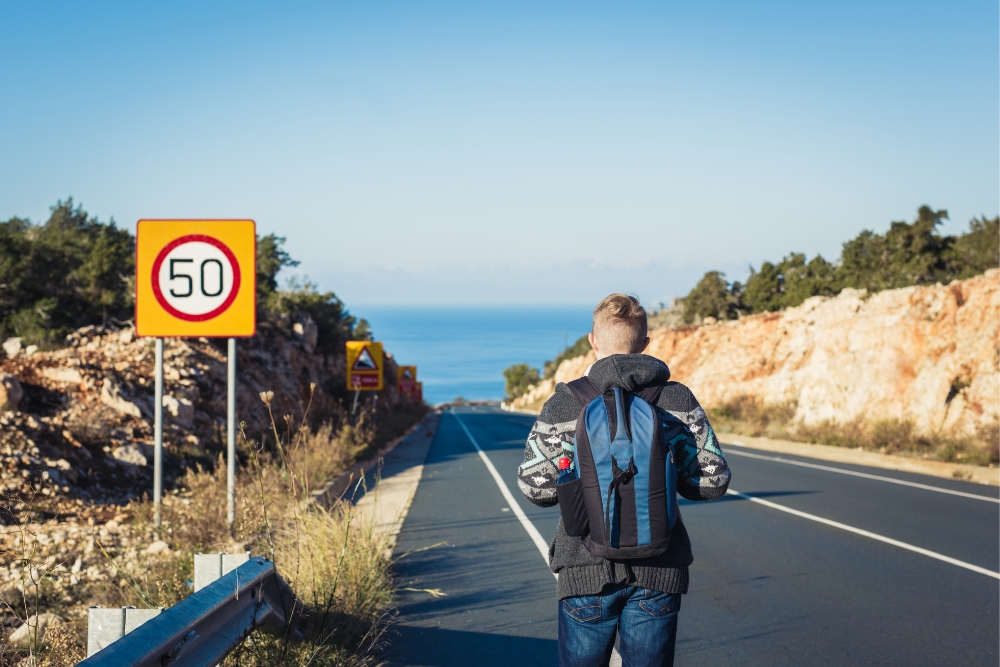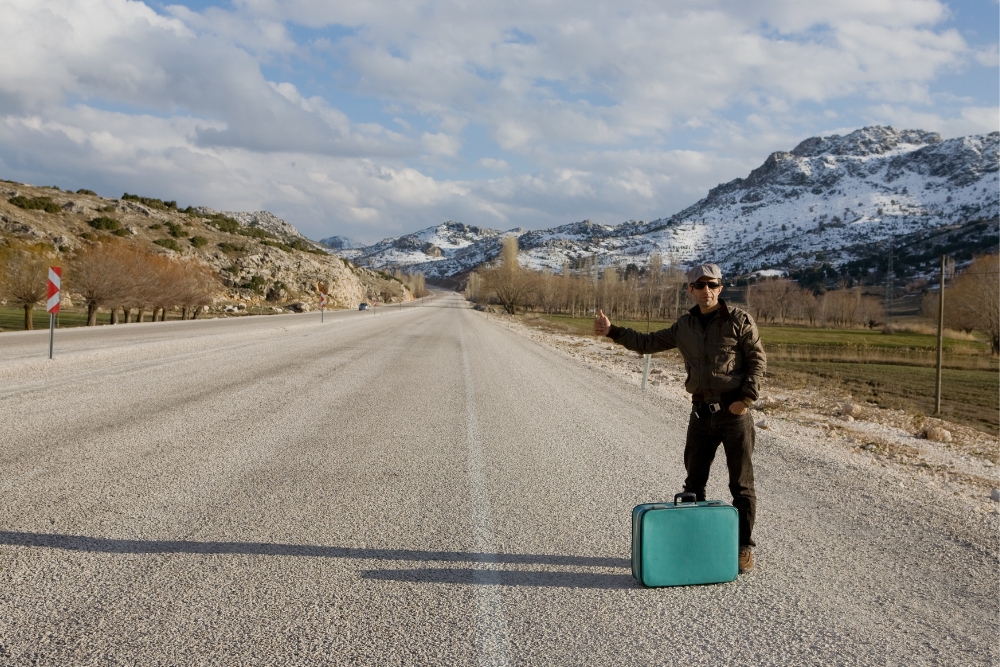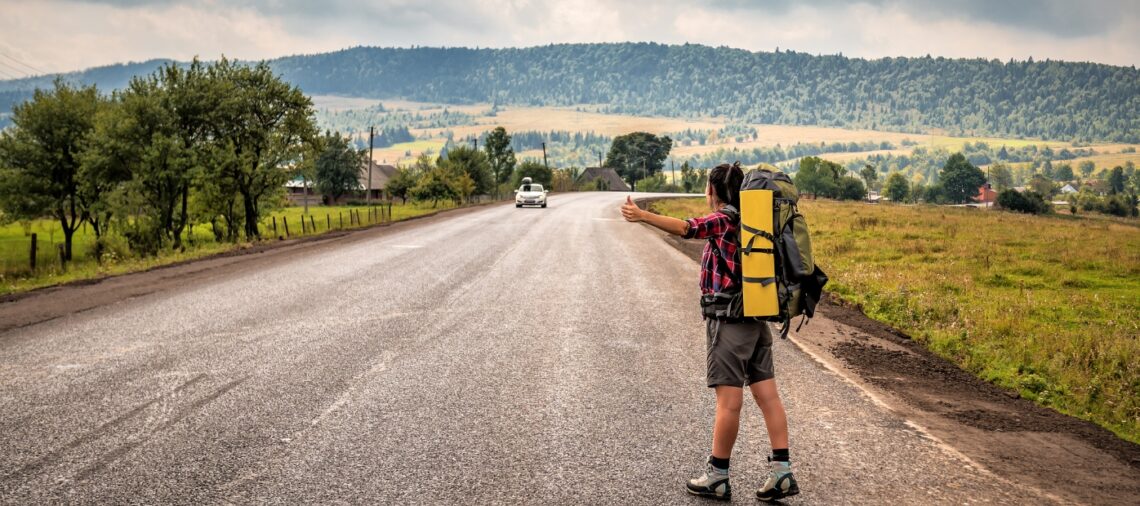Are you tired of spending your hard-earned money on overpriced transportation options? Well… we are here to share some valuable tips and tricks for hitchhiking like a pro when exploring the great unknown. Now, before you start envisioning yourself as the next Jack Kerouac, let us clarify that hitchhiking isn’t just about sticking out your thumb and hoping for the best. It requires finesse, charm, and a touch of luck. So, grab your backpack and get ready for some essential advice about how to hitchhike safely when traveling.
Planning Your Hitchhiking Route

When planning your hitchhiking route, it is crucial to consider various factors to ensure a safe and successful journey. Researching destinations is the first step in mapping out your route. Look for areas with high traffic and easy access to major roads. This will increase your chances of getting a ride quickly. Additionally, consider finding alternate routes to your desired destination. Taking less-traveled roads can sometimes lead to unexpected adventures and more willing drivers.
Utilizing online hitchhiking communities is another helpful resource. These communities provide valuable information about routes, best hitchhiking spots, and potential ride shares. Connect with experienced hitchhikers who can offer advice and recommendations.
Considering the weather conditions is essential for your safety. Check the forecast for your planned route and pack accordingly. Dress in layers to accommodate changing temperatures, and bring rain gear in case of inclement weather.
Lastly, assess local laws and regulations. Hitchhiking may be legal in some areas, while others have restrictions or even outright bans. Familiarize yourself with the rules of each destination to avoid any legal complications.
Choosing the Right Hitchhiking Spots
Choosing the right hitchhiking spots is important to increase your chances of getting a ride quickly and safely. Hitchhiking spot selection plays a crucial role in your hitchhiking journey. Before you set out, doing some hitchhiking spot research is essential. Look for spots known to be safe and frequented by other hitchhikers. These spots often have good visibility, making it easier for drivers to see you and pull over. Besides visibility, hitchhiking spot availability is another important factor to consider. Choose spots with ample room for cars to pull over and pick you up safely.
While selecting a hitchhiking spot, it is equally important to be aware of hitchhiking spot dangers. Avoid spots near busy highways or on-ramps, as they can be dangerous due to high-speed traffic. Instead, look for spots near gas stations, rest areas, or other public places where drivers are more likely to stop.
Dressing Appropriately for Hitchhiking

Choosing the right attire is essential when dressing appropriately for hitchhiking. Your clothing choices can play a significant role in your overall hitchhiking experience. Here are some important factors to consider when it comes to dressing for the open road:
- Weather considerations: Dress according to the weather conditions you may encounter along your journey. Layer your clothing for versatility and pack a waterproof jacket in case of rain. Don’t forget a hat and sunscreen for protection against the sun.
- Cultural appropriateness: Research the cultural norms of the regions you’ll be hitchhiking through. Dressing in a way that respects local customs can help you make a positive impression and foster connections with potential drivers.
When it comes to packing essentials for hitchhiking, keep in mind the following:
- Clothing choices: Opt for comfortable, breathable fabrics that allow freedom of movement. Choose practical items like durable pants, comfortable shoes, and moisture-wicking socks.
- First impressions: Remember that first impressions matter. Dressing neatly and presentably can help you appear trustworthy and approachable to drivers.
Creating Eye-Catching Hitchhiking Signs

Creating an eye-catching hitchhiking sign is an essential skill that can increase your chances of getting picked up quickly and safely. Hitchhiking sign design is an art form that requires creativity and thoughtfulness. To catch drivers’ attention, you need to create a memorable sign that stands out from the crowd.
One way to create an eye-catching sign is to make it artistic. Use bright colors, bold fonts, and creative drawings to make your sign visually appealing. Consider using symbols or images that represent your destination or the road itself. This can help drivers connect with your sign and understand where you are heading.
Another tip is to keep your sign simple and easy to read. Use large, clear lettering that can be read from a distance. Avoid cluttering your sign with unnecessary information or long phrases. Instead, focus on conveying your destination or the direction you want to go.
Approaching Potential Drivers Safely
When approaching potential drivers while hitchhiking, it is crucial to prioritize your safety and be mindful of your approach. Building rapport with the driver is essential, as it helps establish a sense of trust and ensures a more comfortable journey. Assessing the driver’s body language can give you valuable insights into their demeanor and intentions. Look for signs of friendliness and openness, such as a smile or relaxed posture. On the other hand, if the driver seems tense or exhibits aggressive behavior, it’s best to maintain your distance and find another ride. Remember, your safety is paramount.
Establishing trust with the driver is also important. Start by having a brief conversation before getting into the vehicle. Ask about their destination and route to ensure it aligns with your own plans. Share a bit about yourself to create a connection. However, be cautious not to overshare personal information. Setting boundaries is crucial to maintaining your safety. Let the driver know your preferred level of conversation and any topics that make you uncomfortable. If you feel uneasy at any point during the ride, trust your instincts and politely ask to be let out.
Communicating Effectively With Drivers
To effectively communicate with drivers while hitchhiking, it is essential to establish clear expectations and maintain open and respectful dialogue throughout the journey. Building rapport with drivers is key to establishing trust and creating a positive hitchhiking experience. Effective communication involves verbal exchanges, reading body language, and understanding nonverbal cues.
When approaching a potential driver, make eye contact and smile. This will help establish a connection and show that you are approachable. Use clear and concise language to express your destination and ask politely if they are heading in that direction. Pay attention to the driver’s response and body language. If they seem hesitant or uncertain, it’s best to thank them for their consideration and move on to the next potential ride.
During the journey, maintain an open dialogue with the driver. Engage in friendly conversation, ask questions, and actively listen to their responses. This will not only help pass the time but also build a connection and establish trust. If any misunderstandings arise, address them with respect and clarity. Remember, effective communication is a two-way street, so be open to feedback and willing to adapt if necessary.
Trusting Your Instincts and Staying Safe

Trusting your instincts is crucial for your safety while hitchhiking. When you’re out on the road, listening to your intuition and recognizing any possible red flags is important. Here are some key points to keep in mind:
Listening to intuition:
- Your gut feeling is a powerful tool. Trust your instincts and proceed with caution if something doesn’t feel right.
- Pay attention to any unease or discomfort when interacting with potential drivers. Your intuition can often sense danger before your conscious mind does.
Recognizing red flags: - Be wary of drivers who seem overly insistent or pushy. Trust your instincts if you feel pressured into accepting a ride.
- Look out for signs of aggression, erratic behavior, or substance abuse. These can be indicators of potential danger.
In addition to listening to your instincts, there are personal safety measures you can take to ensure your well-being:
Trusting others:
- While it’s important to maintain caution, it is also crucial to trust your fellow travelers. Many hitchhikers have positive experiences and meet incredible people along the way.
- Use your judgment and assess the situation before accepting a ride. Trust your instincts and make an informed decision.
Emergency preparedness: - Always have a backup plan in case anything goes wrong. Carry a fully charged phone, emergency cash, and a list of emergency contacts.
- Share your travel plans with someone you trust so they know where you are and can assist you if needed.
Dealing With Challenging Hitchhiking Situations
Navigating challenging situations while hitchhiking can test your resourcefulness and adaptability. As a hitchhiker, you may find yourself in unexpected situations that require quick thinking and problem-solving skills. One of the most common challenges is dealing with rude or aggressive drivers.
If you encounter a driver who makes you feel uncomfortable or unsafe, trust your instincts and politely decline the ride. It’s important to prioritize your safety above all else. In such situations, it’s helpful to have alternative transportation options in mind.
Familiarize yourself with local bus routes, train schedules, or even ride-sharing services that can provide a backup plan.
Another common challenge is handling language barriers. If you cannot communicate effectively with the driver, try using simple gestures or basic phrases from a translation app.
Additionally, managing fatigue and exhaustion is crucial. Remember to take breaks, stay hydrated, and get enough rest to avoid becoming overly tired. By being prepared for these challenging situations, you can confidently navigate them and continue your hitchhiking journey safely and freely.
Reflecting on the Lessons Learned From Hitchhiking Experiences

Reflecting on your hitchhiking experiences can provide valuable insights and lessons to enhance your future journeys. Reflecting on your adventures, you might realize that hitchhiking is not just about getting from one place to another; it is a transformative experience that can shape your growth and broaden your horizons. Here are some key lessons you might have learned:
- Reflecting on personal growth:
- Hitchhiking challenges you to step out of your comfort zone and discover your inner strength.
- It teaches you to adapt to unpredictable situations and become more resilient.
- Sharing hitchhiking stories:
- By sharing your experiences with others, you can inspire and educate fellow travelers.
- Your stories can foster a sense of community and encourage others to embark on their own hitchhiking adventures.
- Understanding cultural differences:
- Through hitchhiking, you have likely encountered people from diverse backgrounds and cultures.
- These encounters have given you a deeper understanding and appreciation for different ways of life.
- Overcoming fear:
- Hitchhiking can be daunting, especially if you have fears or anxieties about strangers.
- By facing these fears head-on and realizing that most people are kind and helpful, you have learned to trust your instincts and overcome your fears.
- Building trust:
- Hitchhiking relies on trust between drivers and hitchhikers.
- By building trust through open communication and mutual respect, you have experienced the kindness and generosity of strangers.
Reflecting on these lessons will enrich your future hitchhiking journeys and your life. Embrace the knowledge you have gained and continue seeking the freedom and adventure that hitchhiking brings.
Conclusion About How to Hitchhike Safely When Traveling
As you reflect on your hitchhiking experiences, you realize that this art is more than just a means of transportation. It’s a symbol of freedom, connection, and embracing the unknown. Hitchhiking has taught you to trust your instincts, communicate effectively, and stay safe in challenging situations. So, as you continue your adventurous travels, remember the lessons learned from hitchhiking and unlock a world of exciting opportunities on the open road.
Photos: Canva Pro




